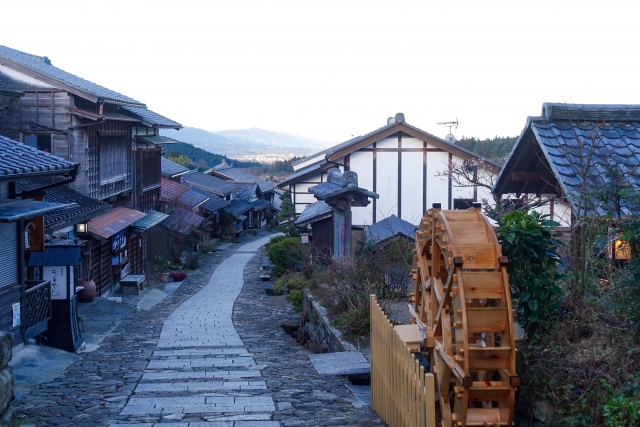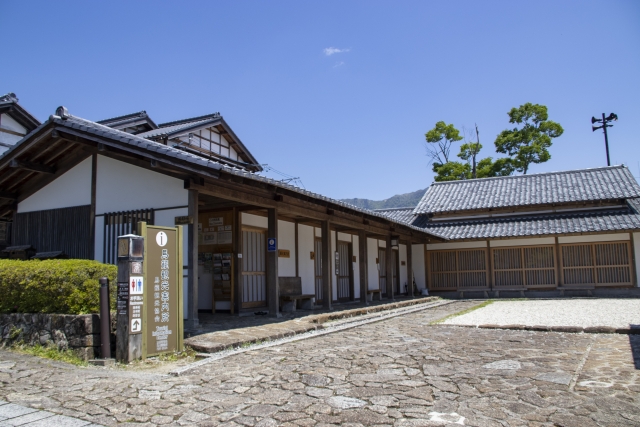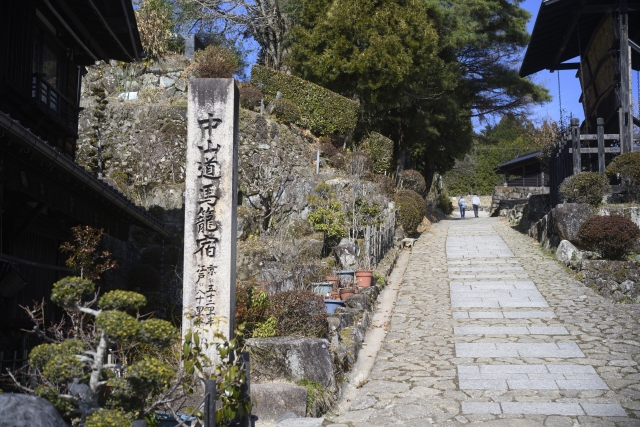Magome-juku – A Historic Post Town on the Nakasendo Trail
Overview of Magome-juku: History and Significance of Magome-juku
Magome-juku is a charming historic post town located on the Nakasendo Trail in Gifu
Prefecture, Japan.
Known for its beautifully preserved Edo-period wooden buildings and scenic views,
Magome-juku offers
visitors a glimpse into Japan's past.
The town is famous for its traditional crafts, local cuisine, and tranquil atmosphere.
Visitors can stroll down the nostalgic streets, savor local treats
like gohei-mochi and
soba noodles,
and enjoy the beautiful surroundings. Magome-juku's peaceful
ambiance and rich history make it a must-visit for anyone exploring Japan’s countryside.



Magome-juku is surrounded by other picturesque and historic destinations such as
Tsumago-juku,
Narai-juku, and
Matsumoto Castle,
making it an ideal base for exploring the charm of Japan’s preserved Edo-period post
towns and cultural heritage
sites.
The scenic trail between Magome-juku and Tsumago-juku is especially perfect for nature
lovers — a peaceful hike
through forests, waterfalls, and old tea houses offers a step back in time.
Annual Events & Traditional Festivals in Magome-juku
| Month | Event Name | Description |
|---|---|---|
| February | Kisoji "Ice and Snow Lantern Festival" in Magome-juku | Experience magical winter scenery with illuminated snow lanterns along the historic streets. |
| June | Hotaru (Firefly) Festival | Enjoy the enchanting sight of fireflies lighting up the night in the Magome area. |
| July | Nagashi Somen Evening | Participate in the summer tradition of catching flowing somen noodles in a bamboo flume. |
| August | Bon Odori, Reimei Taiko Drum Performance, Fujimura Memorial | Traditional Bon dance, dynamic taiko drumming, and a memorial event for author Toson Shimazaki. |
| October | Suwa Shrine Annual Festival | A local shrine festival featuring rituals and community celebrations. |
| November | Magome-juku Festival, Akari Kaido, Autumn Parade, Shimada Park Light-up, Magomeza Kabuki | Autumn events include parades, illuminated streets, historical reenactments, park light-ups, and traditional kabuki performances. |
Event dates and details may vary each year. Please check the official website for the latest information before your visit.
Local Cuisine of Magome-juku
Surrounded by mountains and blessed with abundant nature, Magome-juku is known for its delicious local cuisine. Thanks to the area’s pure, clear water, many soba noodle shops line the streets. Depending on the season, you can enjoy fresh mountain vegetables and river fish, making each visit unique.

One of the most popular specialties is gohei-mochi, which comes in various shapes such as the classic “waraji” (sandal) or round dumpling style. The mochi is coated with a rich sauce made from soy sauce or miso, blended with walnuts, peanuts, or sesame, and then carefully pounded and grilled. The result is a fragrant, chewy treat loved by visitors.
Each shop has its own secret recipe for the sauce, so tasting and comparing different gohei-mochi is highly recommended!
Access to Magome-juku by Highway Bus (Last updated: June 11 , 2025)
The most convenient way to reach Magome-juku is by highway bus. Take a direct highway bus from Busta Shinjuku (Shinjuku Expressway Bus Terminal) to Nakatsugawa Station. From Nakatsugawa, transfer to a local bus bound for Magome-juku. This route is comfortable and often more affordable than taking the train, especially for those traveling from Tokyo.
How to Get to Magome-juku from Major Cities
| Departure City | Route | Estimated Time | Estimated Cost |
|---|---|---|---|
| Tokyo (Shinjuku) | Highway Bus from Busta Shinjuku → Chuo-do Magome (expressway/connecting bus stop) → walk to Magome-juku (20 minutes) | About 5 hours | ¥4,500–¥6,000 |
| Tokyo (Shinjuku) |
Highway Bus from Busta Shinjuku → Nakatsugawa
Station (direct highway bus) Transfer to local bus → Magome-juku |
About 5 hours 30 minutes | ¥5,500–¥6,000 (bus) + ¥600–¥800 (local bus) |
| Tokyo (Shinjuku) |
JR Limited Express Azusa 1 departs Shinjuku (07:00) → Arrive at
Shiojiri
(09:28). Transfer to JR Limited Express Shinano 6 (10:03) → Arrive at Nakatsugawa (11:05). Walk to Nakatsugawa Station Bus Terminal (about 5 min). Take Kitaena Kotsu Magome Line bus (11:10) → Arrive at Magome (11:40). Walk to Magome-juku (about 4 min). |
About 4 hours 45 minutes | ¥9,000-10,000 (train) + ¥800 (bus) |
| Nagoya | JR Chuo Main Line (Ltd. Express Shinano) → Nakatsugawa → Bus to Magome-juku | About 2 hours | ¥3,000–¥4,000 |
| Matsumoto |
JR Limited Express Shinano → Nakatsugawa (direct train) Transfer to bus → Magome-juku |
About 1 hour 40 minutes | ¥3,000–¥4,000 (train) + ¥600–¥800 (bus) |
Where to Stay in Magome-juku
While Magome-juku can be enjoyed as a day trip, staying overnight allows you to experience the town's peaceful evening ambiance after the crowds leave. Here are a few accommodations within walking distance:
- Magomechaya Guesthouse – A traditional inn located right on the main street. Offers Japanese-style rooms and home-cooked meals.
- Tajimaya Ryokan – Family-run ryokan with excellent hospitality and a rustic, nostalgic atmosphere.
- Guest House Gaku Magome – Budget-friendly option with dorm-style rooms, ideal for hikers.
Most inns require advance reservations, especially during spring and autumn. We recommend booking early to ensure availability.
Note: If you want to travel quickly by taking the Limited Express "Azusa or Shinano" you will need to purchase a limited express ticket (tokkyu-ken).
Note: If you plan to use the highway bus, advance reservation is strongly recommended as seats are limited. Please secure your seat in advance through the official website or reservation platforms.
Note: The "Chuo Line" is part of the Chuo Main Line. In the Tokyo (Kanto) area, it is commonly referred to as the "Chuo Line," but officially it is the Chuo Main Line. Please be aware of this naming difference when checking train routes or schedules.
From Nakatsugawa Station, take the bus to Magome-juku. Follow the signs to explore the historic district, lined with traditional inns, shops, and cafes.
Frequently Asked Questions about Magome-juku
How to get to Magome-juku by train from Nagoya?
Take the JR Chuo Main Line (Ltd. Express Shinano) from Nagoya to Nakatsugawa, then transfer to a bus to Magome-juku.
How to get to Magome-juku by train from Shinjuku (Tokyo)?
Take the JR Chuo Line (Ltd. Express Azusa) from Shinjuku Station to Shiojiri, then transfer to a local train to Nakatsugawa, and finally take a bus to Magome-juku.
Is Magome-juku open year-round?
Yes, Magome-juku is open year-round. However, some shops and attractions may have limited hours or close during the winter months.
Are there any entry fees to visit Magome-juku?
There is no fee to explore the town itself. Some museums or historical houses may charge a small admission fee.
What local specialties to try in Magome-juku?
Try gohei-mochi, chestnut sweets, and local soba noodles. The town is also known for its scenic views and historical sites.
How long to spend in Magome-juku?
Half a day is enough to explore the main street and highlights, but a full day allows for a more relaxed visit and time to enjoy local food and shops.
Is a special ticket needed to ride the Limited Express Azusa or Shinano to Magome-juku?
Yes, in addition to a regular train ticket, a limited express ticket (tokkyu-ken) is required to ride the Limited Express Azusa or Shinano trains. This ticket can be bought at ticket counters or machines at major JR stations.
Can Magome-juku be reached from central Tokyo by bus?
Yes, a highway bus from Busta Shinjuku (Shinjuku Expressway Bus Terminal) goes to Nakatsugawa. From Nakatsugawa Station, transfer to a bus to Magome-juku. Advance reservation for the highway bus is essential, especially during busy seasons.
Activity Information
- Location: Magome-juku, Gifu Prefecture, Japan
- Opening Hours: Most shops and attractions open during the day; check specific timings for each place
- Recommended Season: Spring to Autumn is ideal for walking and sightseeing
- Notes: Wear comfortable shoes for walking along the cobbled streets. Try local specialties like gohei-mochi and soba noodles.
- Entry Fee: Free to explore the town; some attractions may have a small fee
Average Monthly Temperatures in Magome-juku
This chart shows the average monthly temperatures in Magome-juku. There are
significant temperature differences throughout the year, so sun protection or warm
clothing may be necessary depending on the season. Please use this as a
reference.
Unit: ℃
| Month | Lowest | Average | Highest |
|---|---|---|---|
| January | -5.6 | -0.8 | 4.8 |
| February | -5.0 | 0.4 | 6.4 |
| March | -1.7 | 4.3 | 10.9 |
| April | 3.7 | 10.2 | 17.4 |
| May | 9.2 | 15.1 | 21.8 |
| June | 14.1 | 19.2 | 25.0 |
| July | 18.3 | 22.8 | 28.6 |
| August | 19.0 | 23.7 | 30.9 |
| September | 15.4 | 19.7 | 26.2 |
| October | 8.3 | 13.2 | 19.9 |
| November | 2.2 | 6.8 | 13.8 |
| December | -2.8 | 1.7 | 7.7 |
- November to April: Down jacket, 🧤gloves, sweaters, and other warm clothing are essential. Temperatures can be very low, so please take adequate precautions against the cold.
- April: There can be some warm days, so we recommend wearing layers that you can adjust easily.
- May, June, September, October: A light jacket or jumper and long sleeves are recommended, as temperatures can fluctuate. Bring layers you can easily add or remove. The sun can be strong, so consider bringing a sun hat, sunglasses, or a light scarf for extra protection.
- July & August: 🕶️Sunglasses, a hat, and a light jumper are recommended. A scarf or shawl that can be adjusted is useful. Weather can change quickly, so bringing rain gear is also advised.